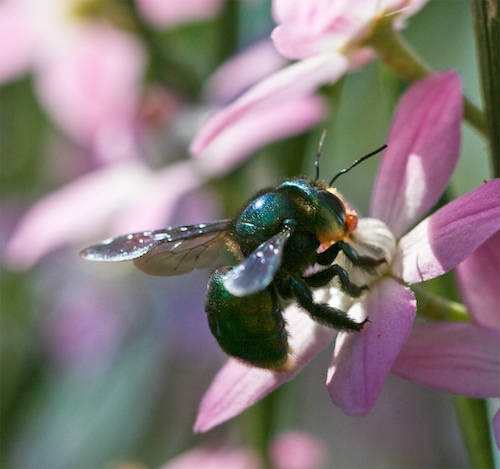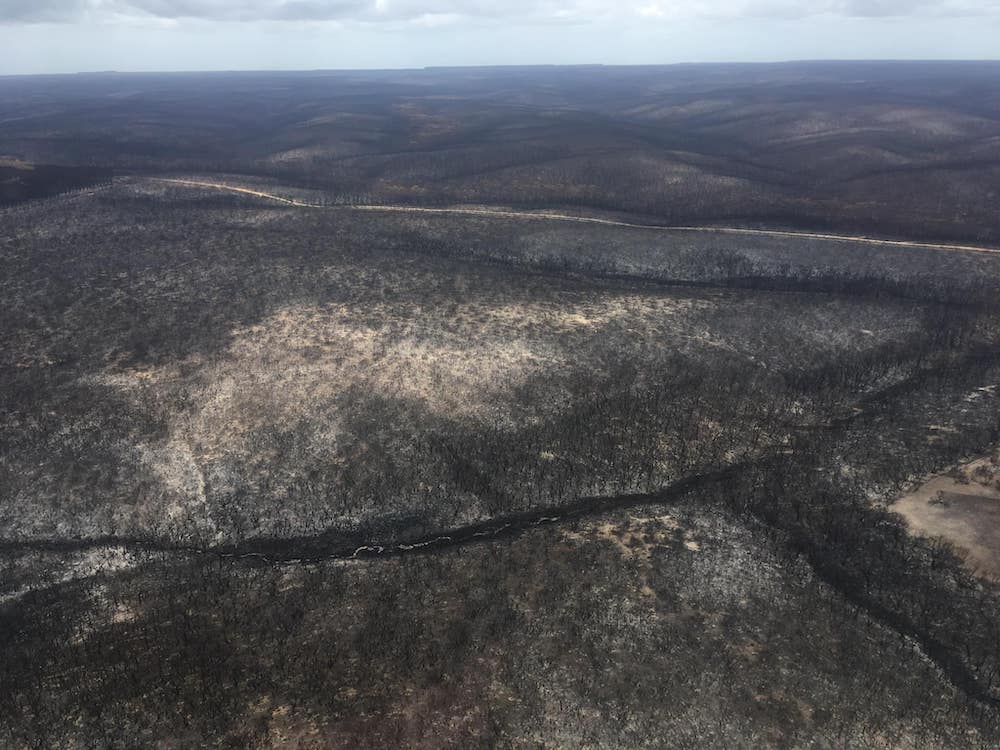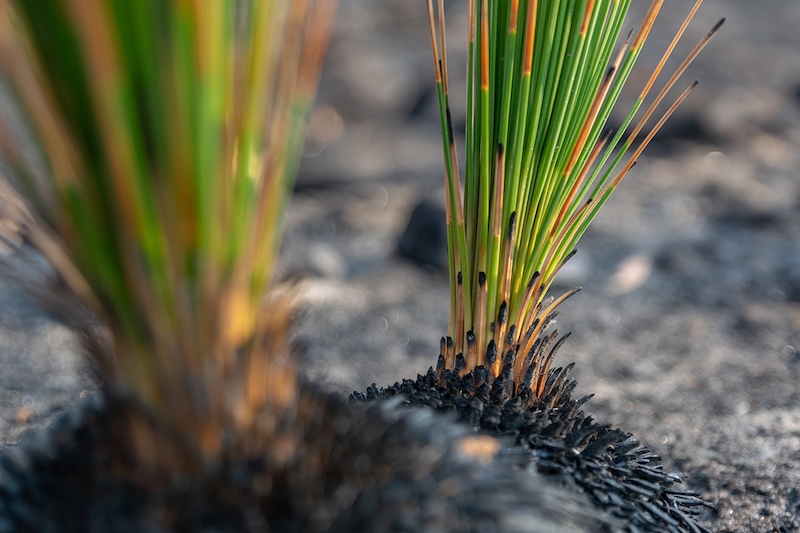In early October, a team of TERN ecologists will return to Kangaroo Island to re-survey 12 permanent environmental monitoring plots established by TERN in 2018, half of which were burnt in the 2019/2020 bushfires. The new data collected by the TERN Field Team will add to key baseline information collected pre-fire and enable the tracking of post-fire recovery rates and ecosystem resilience.
Established in partnership with local landholders and the NGO Kangaroo Island Land for Wildlife, the TERN plots are located within known habitats of the endangered Kangaroo Island dunnart and green carpenter bee.
The collaboration is working to better understand and protect these iconic species on Kangaroo Island—in addition to many other plant and animal species affected by the recent fires.
TERN established 12 permanent environmental monitoring plots on Kangaroo Island in 2018, collecting key baseline vegetation and soil information that will enable scientists to track post-fire recovery rates and ecosystem resilience – Download the 2018 summary report of TERN monitoring plots on Kangaroo Island (credits: TERN)
TERN has 12 permanent environmental monitoring plots on Kangaroo Island (white dots), half of which were burnt in the 2019/2020 bushfires (yellow lines indicate fire extent) (credits: Esri, DigitalGlobe, GeoEye, Earthstar Geographics, CNES Airbus DS, USDA, USGS, AEX, Getmapping, Aerogrid, IGN, IGP, Swisstopo, and the GIS user community)
Data on ecosystem requirements for endangered species
The Kangaroo Island dunnart (Sminthopsis aitkeni) is a small carnivorous marsupial found only on Kangaroo Island. The species was endangered before the recent fires, when catastrophically 95% of the remaining habitat was burnt.
“The rigorous plant and soil data collected by TERN are incredibly valuable and complementary to the work of fauna-based groups such as Kangaroo Island Land for Wildlife. TERN surveyed sites with dunnarts present before the recent fires and by re-revisiting these sites in October post-fire, we’re able to establish a big picture of ecosystem requirements of this endangered species.
The in-depth data collection is an amazing opportunity not otherwise available. It is fantastic TERN monitors Australia’s ecosystems for the long-term.”
Pat Hodgens, Kangaroo Island Land for Wildlife

Pat Hodgens of Kangaroo Island Land for Wildlife sets a camera trap to monitor the recovery of the endangered Kangaroo Island dunnart (credit: Kangaroo Island Land for Wildlife)
Another endangered species that could benefit from ongoing TERN monitoring is the green carpenter bee (Xylocopa aerata).
The last remaining population of green carpenter bees in South Australia is found on Kangaroo Island and entomologists warn that with the loss of large areas of long-unburnt banksia habitat, the future of the green carpenter bee is uncertain.

Local Kangaroo Island ecologists, including Dr Richard Glatz of D’Estrees Entomology & Science Services (right in centre) are working with TERN to monitor green carpenter bee (above) habitat (credit: Louise Docker from Sydney, Australia / CC BY; and TERN)

Dr Richard Glatz, Principal Scientist of D’Estrees Entomology & Science Services on Kangaroo Island, has been working with TERN since 2018 to record plants and soil property at plots with green carpenter bees.
“We have started looking at various locations to undertake specific surveys on the carpenter bees, so the TERN surveys will help us better understand the state of vegetation in the bees’ preferred habitats.
There are numerous endemic, rare and undescribed invertebrates on Kangaroo Island and our understanding of invertebrate ecology is relatively poor, especially with regard to fire impacts. The standardised nature of the TERN sites, and associated plant and soil data, provide great potential to establish invertebrate monitoring protocols there. This would help understand how specific components of Invertebrate communities—and their ecological functions—change over time, and to understand why these changes occur.
For the carpenter bee itself, the TERN sites could help us understand dynamics of the bees nest substrate (Banksia and yacca) within the broader plant community, or to assess the amount of available food resource associated with environmental variables such as rainfall or fire.”
Dr Richard Glatz, D’Estrees Entomology & Science Services, the University of Adelaide and the South Australian Museum
Improving Australia’s climate and disaster resilience
Monitoring data from these surveys, and others at TERN sites around Australia, are a key enabler for improving Australia’s climate and disaster resilience, with the importance of long-term ecosystem monitoring emphasised in CSIRO’s 30 June 2020 report to the Prime Minister.
Dr Nick Gellie, of the University of Adelaide and TERN’s Ecosystem Surveillance platform, says that the data collected by TERN before and after extreme events present a myriad of possibilities for Australian and international research and management communities.
“In particular, in the wake of such catastrophic fires in Australia, TERN’s ecosystem monitoring presents a positive and unique opportunity to gain critical insight into post-fire recovery and future management. In this instance, by revisiting the 12 burnt and unburnt sites on Kangaroo Island, TERN will be able to present a robust post-fire data snapshot—before-after and control and impact.
Such detailed data provided by TERN are seldom available to researchers and decision-makers and will shed light on the dynamics of fire and ecosystem recovery in Australia’s important ecological communities.”
Dr Nick Gellie, University of Adelaide and TERN
- The Terrestrial Ecosystem Research Network (TERN) is Australia’s land ecosystem observatory. Enabled by NCRIS, TERN measures key terrestrial ecosystem attributes over time from continental scale to field sites at hundreds of representative locations and openly provides model-ready data that enable researchers to detect and interpret changes in land ecosystems.
- The TERN sites on Kangaroo Island are part of a national network of more than 750 ecosystem surveillance reference plots that are monitored over time for changes in plant and soil parameters. Data and samples from these plots are all openly available.
- The TERN Field Team will be conducting surveys on Kangaroo Island from 6 -16 October
- For media enquiries please contact TERN’s Science Communication and Engagement Manager, Mark Grant.

It has been estimated that 95% of the remaining Kangaroo Island dunnart habitat was severly burnt during the 2019/20 bushfires (credit: Kangaroo Island Land for Wildlife)








